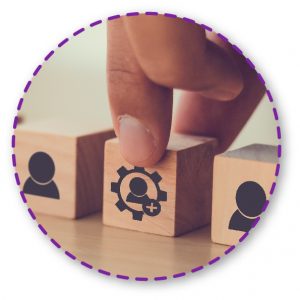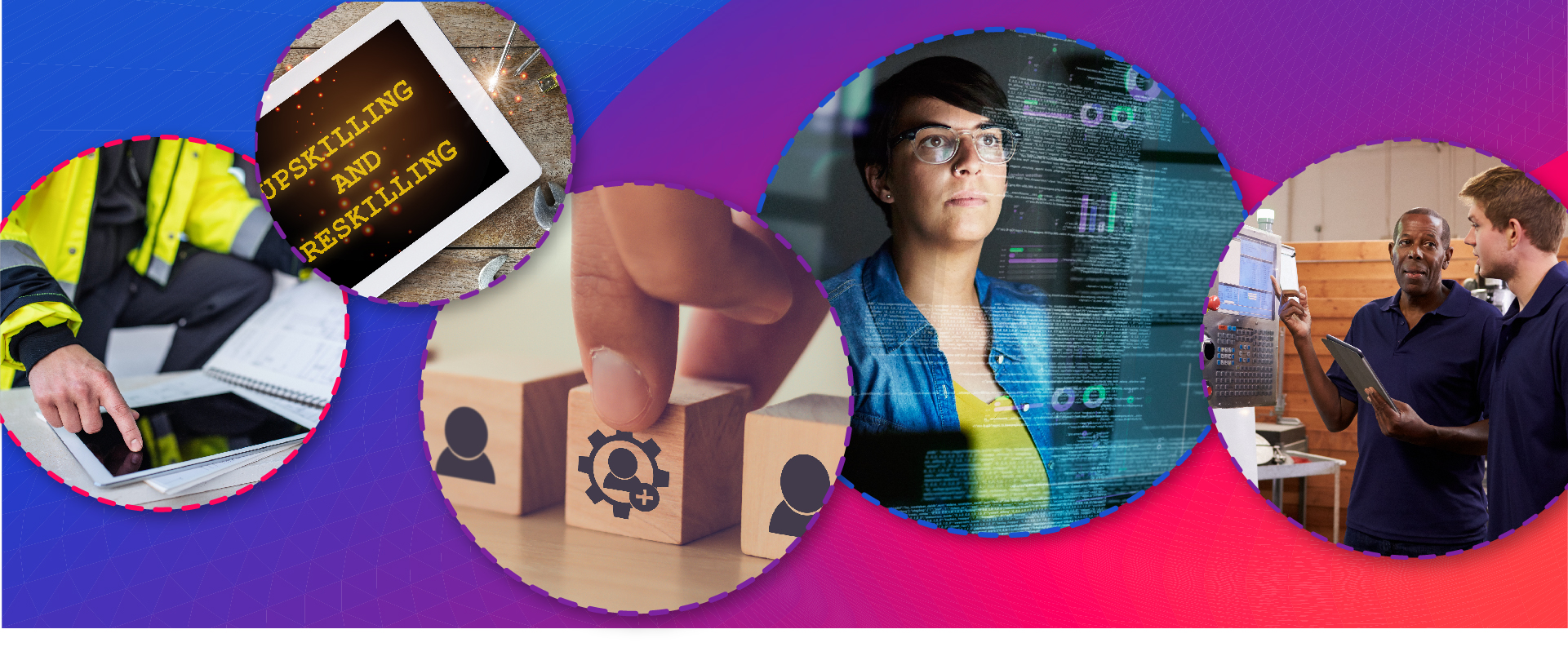The need for reskilling and upskilling in facilities management is critical given the myriad complexities and accelerating changes we face. We have an aging workforce, we have difficulty recruiting and retaining skilled trades, and we are losing many frontline staff to other local employment opportunities. Yet, there is an ongoing need for professional staff at every level, some driven by evolving technologies, the increasing complexities of facilities services, and the shifting expectations of those we serve. In addition, we must focus on enhancing everyone’s soft (or essential) skills, those uniquely “human” skills such as listening and effective communication, critical thinking, interpersonal relationship building, active learning, and curiosity. The power of the “people factor” in the workplace cannot be underestimated.
The Many Faces of Change
 Change and uncertainty undergird life as we know it, but not all change is the same. We’ve typically managed our organizations and institutions through times of “incremental” change. However, in 2007 Apple launched the iPhone, a technological marvel that was truly transformational. The iPhone and all the corresponding industries surrounding it accelerated change simultaneously, interdependently, and exponentially. Follow that with “disruptive” change, which will demand educational institutions’ attention well into the future. Finally, we have been experiencing “destructive” change through climate change and environmental degradation.
Change and uncertainty undergird life as we know it, but not all change is the same. We’ve typically managed our organizations and institutions through times of “incremental” change. However, in 2007 Apple launched the iPhone, a technological marvel that was truly transformational. The iPhone and all the corresponding industries surrounding it accelerated change simultaneously, interdependently, and exponentially. Follow that with “disruptive” change, which will demand educational institutions’ attention well into the future. Finally, we have been experiencing “destructive” change through climate change and environmental degradation.
Then came COVID-19. The pandemic revealed the many weaknesses and dysfunctions in society, educational institutions, and our facilities organizations. COVID was the fuel added to accelerating change. Disruptions that had existed prior to COVID were slowly emerging. Scott Galloway, professor of marketing at NYU Stern School of Business, put it perfectly: “Things won’t change as much as they will accelerate. While other crises reshaped the future, COVID-19 is just making the future happen faster.” And as Jack Welch, former CEO of General Electric, once said, “If the rate of change on the outside exceeds the rate of change on the inside, the end is near.” Indeed, this has been occurring in the realm of technology for some time—technological change continues to pick up speed while human capacity struggles to keep up. This is relevant in considering the challenges we face and the need for skilling and reskilling.
First some context. Higher education experienced pandemic-induced enrollment drops, while many institutions in the Northeast and Midwest were already reeling from a steady decline, and international student enrollment had been declining since 2015. This downturn is increasingly problematic when coupled with global competitiveness for students from other countries such as China, India, Australia, the United Kingdom, and Canada. Add to this the steady decline in state support, tuition remaining high and out of touch for so many, and student debt exceeding $2 trillion. These trends are all going in the wrong direction—and all are unsustainable! They reinforce Scott Galloway’s point that the future is definitely happening faster.
Yet, on the bright side, parents and students still want that college experience, and want to be on our campuses. As revealed in Ian Bogost’s article, “America Will Sacrifice Anything for the College Experience” (The Atlantic, October 2020), facilities professionals are key to ensuring a positive college experience. Your places and spaces matter!
The Fourth Industrial Revolution and the “Third Education Revolution”
Enter technological change and the advent of the Fourth Industrial Revolution. Several of its elements deserve note: We find ourselves big data-driven; Internet of Things (IoT)-enabled; operations technology (OT)-engineered; artificial intelligence (AI)-elevated; 5G-fueled; and blockchain-secured. I have found this list (crafted by Don Guckert, Past APPA President and now Vice President of APPA Advisors) most helpful in thinking about the components of this change and their interrelationships. Indeed, each component is feeding off the other and exponentially driving, enabling, or accelerating the rate of change.
This has significant import for our skilled trades personnel and alters the very nature of job skills and expectations for mechanics and technicians. The shortage of and competition for skilled trades talent has existed for over ten years, and the struggle is heating up. There is no magic solution to this issue. However, several institutions have created apprenticeship programs and work with their local vocational-technical institutes or high schools to train their own staff in-house, provide opportunities for internal promotability, and increase their pool of diverse applicants.
Suffice it to say that the technological shifts of the Fourth Industrial Revolution and the skills gap/needs for the skilled trades are driving the “Third Education Revolution,” in which learning and literacy are key to our future success. Jeff Selingo (formerly of The Chronicle of Higher Education) coined that phrase, stating, “The world of work is undergoing a massive shift. Not since the dawn of the Industrial Revolution in the 18th and 19th centuries and the Information Age that followed in the last century has the scale of disruption taking place in the workforce been so evident.” That “scale of disruption” further reinforces Scott Galloway’s point.
- What it could mean for us is reflected in this handful of relevant megatrends. Don Guckert envisioned ten megatrends. For my purpose, these three are particularly relevant:
- From valuing institutional knowledge to valuing shared knowledge;
- From rewarding expertise to rewarding collaboration;
- From competing with the machine to complementing it.
Doing Different with Less
Hence, “What we do will change. How we do it will change even more.” If we put it in terms of Charles Darwin’s theory of evolution, it is not the strongest of the species that survive, nor the most intelligent, but those most responsive to change. In other words, we must adapt! Our mindset needs to move from doing more with less to doing different with less! One example is Dick  Fosbury, who competed in the high jump during the 1968 Olympic Games. By introducing his backwards flip, the Fosbury Flop, he broke old, preconceived boundaries and changed the entire approach to the high jump.
Fosbury, who competed in the high jump during the 1968 Olympic Games. By introducing his backwards flip, the Fosbury Flop, he broke old, preconceived boundaries and changed the entire approach to the high jump.
Another example is depicted in the movie Moneyball. Billie Beane (general manager of the Oakland Athletics—last in the league) and Pete Brand (25-year-old Yale graduate of economics) literally transformed how to win in baseball during the course of one season. Everyone thought they were crazy and said as much: How did they do it? They approached the game differently by using statistics related to hitting and getting on base, signing less-expensive players rather than home-run hitters, and showing how you could win by doing different with less (money). In the 2002 season, the Oakland As went on a winning streak of 20 games straight. That record has yet to be broken. The Boston Red Sox applied this new way of thinking and won the pennant two years later.
Fast forward to the buildings and facilities industry, where commercial/corporate real estate is now using smart technologies (AI) to gather thousands of sensor data points in order to drive predictive analytics that will provide more information for more effective and responsive decision making.
Shifting from Knowing to Learning
Doing different will require different skills. People with the right qualities will thrive in this complex future. So, what are those skills and qualities? In exploring job skills in demand for the future, these were the top five identified by Bernard Marr & Company:
5. Emotional intelligence (understanding one’s emotions along with those of others)
4. Creativity (imagination and innovation)
3. Flexibility and adaptability (change by unlearning, learning, and relearning)
2. Data literacy (data is fueling the Fourth Industrial Revolution)
1. Tech savvy-ness (effective utilization of various technologies)
Spending time initially on technological shifts supports the first two job skills (above) more strategically, not only to get your job done efficiently and productively, but to use data for informed decision making. The other three qualities have to do with how you get the job done—how you deal with change, how resourceful you are, and how you relate to others—and lead us down the “soft skills” path.
Mara Swan, executive vice president for global strategy and talent at the Manpower Group, stated, “Employability depends less on what you already know and more on how well you can learn, apply, and adapt.” Those traits will be essential in the new workplace, because in fact, most jobs of the future don’t even exist yet! Part of this labor shift has been called the Great Resignation; the other I’ve deemed the age of the Great Retirements.
- First, the Great Resignation. There’s no one reason why people quit, but the pandemic accelerated those trends and has realigned workforce thinking about the nature of work. Check out these statistics:
- Quit rates had been rising since 2010, but broke all records by mid- to late 2021— Society for Human Resource Management;
- 1 in 4 people are actively searching for a new job—Workplace Health
- 80% are concerned about career development—Wall Street Journal
- 72% are now rethinking their skillsets—Wall Street Journal
- Well over 2 million fewer women are now in the labor force—Bureau of Labor Statistics
- Mothers of young children reduced their hours 4-5 times more than fathers—Washington University in St. Louis
- Baby Boomers are now retiring at twice the rate they did in 2019—Pew Research Foundation.
 Considering all these statistics, the significance of good, solid leadership cannot be underestimated for its impact on employee job satisfaction, quality of life, sense of control, workplace transparency, and performance. What are you doing to support, encourage, and invest in your staff?
Considering all these statistics, the significance of good, solid leadership cannot be underestimated for its impact on employee job satisfaction, quality of life, sense of control, workplace transparency, and performance. What are you doing to support, encourage, and invest in your staff?
Winning the “War for Talent”
This skills gap is indeed an urgent concern, or should be. Coupled with employees’ concern for advancing their careers and rethinking their skillsets, an organization can serve to teach staff the importance of lifelong learning and secure a serious competitive advantage. This is one important way to win the “war for talent” and correspondingly create a highly productive work environment.
Additionally, the Great Resignation has had an outsized impact on working women and caregivers. Current working conditions and organizational structures are broken. Behind this exodus of working women lies economic, societal, and social identity-based factors forcing women and caregivers to manage difficult decisions (childcare costs; uncompensated caregiving work/responsibilities; gender-driven identity roles; taxing impacts on physical and mental health; increased hostility and harassment in the home; etc.). All of these need attention through policy changes for sponsored childcare, expanded paid leave, flexible hours and schedules, and investment in community networks. These aren’t radical changes. The cost of implementation is far short of the overall expense of replacing employees and reengaging in recruiting and hiring new ones.
As for the Great Retirements, times have changed with respect to succession planning. It’s no longer about identifying the tasks for a role or one role. It’s more about succession management through developing adaptable talent for an evolving role and organization. Therefore, when hiring, we should focus on what the job might need or become, not what it is now or worse yet, what it was! That requires different job descriptions, different interviewing techniques, and different hiring protocols. Author and educator A.J. Juliani’s statement about education applies equally to the world of work: “Our job is not to prepare students for something. Our job is to help students prepare themselves for anything.”
Again, people with the right qualities will thrive in this complex future. As a matter of fact, Jack Ma, CEO of China’s Alibaba, stressed that we shouldn’t try to compete with machines. Cloud data teaches machines to get smarter—instantly. Hence, machines will always be the experts and beat us every time. So we should collaborate with machines to understand and further decipher what they are telling us, thereby complementing machine intelligence through “augmented work” to reimagine and improve the employee work experience with technology.
Soft Skills in Demand
Therefore, the answer is to become more human. That touches on the area of soft skills or what some call “essential skills.” Indeed, there’s an accelerating demand for soft skills and workplace flexibility to transform the workplace. Facilities services is one of the top ten industries where soft skills are most common and most needed—and recognize that includes all staff. Everyone needs soft skills training. LinkedIn Global Talent Trends stated:
Soft skills have always been important, and they’re increasingly vital today. The rise of automation and artificial intelligence means that hard skills alone are no longer enough to be successful. And while the half-life of many hard skills is shrinking, soft skills stay relevant: a particular programming language may go out of fashion, but creativity, adaptability, and collaboration skills will always be valuable.
Therefore, preparing for every future means to be better prepared with the soft skills necessary to thrive in an ever-changing and accelerating world. Following are a few of the soft skills that are hard to find yet will be increasingly valued by employers: creativity, imagination, persuasion, collaboration, adaptability, resilience, communication, active listening, time management, empathy, integrity and trust, desire to learn, and curiosity (which can indeed be promoted and nurtured). These are all human skills. Unfortunately, there is not enough training and development provided. Add to this the amount of lost productivity and revenue from unengaged or underengaged employees, and this challenge grows exponentially.
The speed of change and the speed of learning are occurring at the speed of now! That’s no different with respect to the speed of communication. It’s all changed. We’re living in a bits and bytes world, and our styles of communicating must keep pace, especially since humans now have an attention span shorter than that of a goldfish! Paraphrasing Nobel Laureate Herbert Simon, Julian Birkinshaw, London Business School professor, aptly said, “In a world where information is plentiful, the scarce resource we have to manage is not information, it is attention.” Further proving his point, he observed, “If we allow technology to take over our decision-making and the way we work, there is the risk that we overly quantify everything.” We need to harness these people skills despite all the promises of technological progress in order to support the change(s) needed to succeed individually and organizationally.
Training: Investing in Success
To get there takes training dollars. Unfortunately, training and development funding continues to lag given the need for employee investment. Training really is about an investment in the employee, the organization, and the institution’s success. For example, on average the professional development investment per employee per year averages $1,046. Yet the cost of turnover per employee averages $45,000–$60,000. Hence, it’s over 4,000% less expensive to invest in staff professional development than to bear the costs associated with staff turnover. As companies face unprecedented staffing shortages, investing more in training can save money and reduce the skills gap challenges. Multiple studies identify professional development as one of the most important things for employees. We must increase our investment in these training programs.
 Frankly, you may have little control over the important employee benefits, health, and wellness programs offered by your institution. However, you do have sway over professional and career development, which is exactly what employees want, let alone need. For example, research from four separate entities (LinkedIn, Harvard Business Review, Gallup, and Manpower Group) validates Millennials’ top priorities: They believe that professional development and the opportunity to learn new skills are their keys to advancement. Providing these are not only crucial to their recruitment—they are the reasons Millennials will leave!
Frankly, you may have little control over the important employee benefits, health, and wellness programs offered by your institution. However, you do have sway over professional and career development, which is exactly what employees want, let alone need. For example, research from four separate entities (LinkedIn, Harvard Business Review, Gallup, and Manpower Group) validates Millennials’ top priorities: They believe that professional development and the opportunity to learn new skills are their keys to advancement. Providing these are not only crucial to their recruitment—they are the reasons Millennials will leave!
In addition, the Great Resignation emphasizes that lack of professional development is indeed the number two reason people leave. The number one reason is the lack of a sense of belonging: the feeling of working in a welcoming environment, being heard, and having a voice. This is further substantiated by Kevin H. Johnson in “Enough With The Millennial Bashing” (Forbes, June 19, 2018), who said:
Millennials give their educational preparation high marks, and 73% also recognize they’ll have to continue gaining new skills. They’re ready to put in the effort, and 86% have confidence in their ability to keep their skill sets up to date. However, less than half (42%) said their current employers provide learning, development, and training opportunities.
As I see it, virtual training lets you do more for less and schedule more without the same time constraints. It’s not perfect, but shy of being able to send everyone to face-to-face training programs, it does provide a learning environment so necessary for people to learn to work together, own their learning experience, and get critical skills training. Frankly, both virtual and face-to-face training and professional development, along with flexibility in the workplace, are critical elements for the many challenges we face today. We can compete.
However, this isn’t all on the employer or organization. The other part of this equation is on you—each and every one of us. This quote by William Pollard really captures it for me: “Learning and innovation go hand in hand. The arrogance of success is to think that what you did yesterday will be sufficient for tomorrow.”
The Modern Economy has really become the Learning Economy, where our capacity for learning is becoming the currency we trade on during our careers. Where we once went to work to learn to do a job, learning now is the job. Confirming my point, Microsoft CEO Satya Nadella echoed the importance of learning when he said, “The learn-it-all will always do better than the know-it-all.” And Thomas Friedman reiterated, “In this age of acceleration, you will only be able to be a lifelong employee if you are a lifelong learner.” The answer: “Keep learning in a world that never stops changing.” Be a continuous learner!
Lander Medlin is president and CEO of APPA. She can be reached at [email protected].



